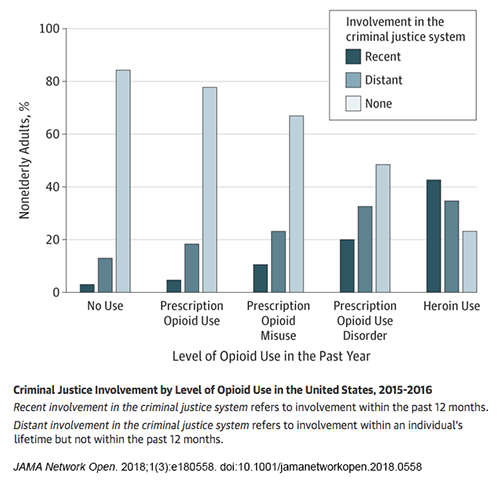Opioid Addiction and the Criminal Justice System
 Each year, the increasing number of people who have opioid addictions impacts communities across the United States. In 2016, substance overdoses (fueled by opioid addictions) surpassed death by car accidents and guns as the leading cause of death for Americans under 50 years old, and in 2017, 134 people died each day from opioid overdose. Opioid use has a significant correlation to criminal justice involvement, and the consequences of opioid addictions can impact everyone from the people seeking recovery to law enforcement first responders, correctional facility staff, and reentry professionals. Despite efforts to promote recovery and reentry, when people who have opioid addictions are released from prison or jail, they often face a significantly higher risk of overdose and overdose-related death than people who were never incarcerated. In North Carolina alone, the risk of overdose death from opioids was 40 times higher for people released from incarceration in state facilities than it was for the general population in the state.
Each year, the increasing number of people who have opioid addictions impacts communities across the United States. In 2016, substance overdoses (fueled by opioid addictions) surpassed death by car accidents and guns as the leading cause of death for Americans under 50 years old, and in 2017, 134 people died each day from opioid overdose. Opioid use has a significant correlation to criminal justice involvement, and the consequences of opioid addictions can impact everyone from the people seeking recovery to law enforcement first responders, correctional facility staff, and reentry professionals. Despite efforts to promote recovery and reentry, when people who have opioid addictions are released from prison or jail, they often face a significantly higher risk of overdose and overdose-related death than people who were never incarcerated. In North Carolina alone, the risk of overdose death from opioids was 40 times higher for people released from incarceration in state facilities than it was for the general population in the state.
The resources below are designed to assist correctional agencies, community-based treatment providers, probation and parole agencies, and other service providers in better responding to people who have opioid addictions who are in the criminal justice system.
Publications
- Best Practices for Successful Reentry for People Who Have Opioid Addictions
People who are leaving incarceration face a significantly higher risk of relapse, overdose, and overdose-related death than people in the general public. Because of these odds, reentry is a critical time to provide rapid access to pre- and post-release treatment as well as informed supervision to people who have opioid addictions. This fact sheet from the National Reentry Resource Center describes the best practices that correctional, community-based behavioral health, and probation and parole agencies can implement within their systems to ensure reentry for people who have opioid addictions is safe and successful.
Webinars
- “Best Practices for Successful Reentry for People with an Opioid Addiction” This webinar provides agencies with information on how to support people who have opioid addictions in successfully returning to their communities. These best practices include planning and coordination, behavioral health treatment, cognitive interventions, and community supervision as well as community resources such as housing and recovery support services.
- “Medication Assisted Treatment in Jails and Community-Based Settings” Medication-assisted treatment (MAT) is an evidence-based practice that can be an important tool to assist in a person’s recovery from opioid addiction. This webinar features speakers from two jurisdictions that have used two forms of MAT—methadone and naltrexone—within their reentry programs.
- “Opioid Addiction Screening and Assessment for People in the Criminal Justice System” During this webinar, Dr. Roger Peters of the University of South Florida reviews available screening and assessment instruments and discusses instrument selection and specific considerations for identifying and assessing people who have opioid addictions. Dr. Peters—along with Jac Charlier and Phillip Barbour of the Center for Health and Justice at Treatment Alternatives for Safe Communities—also explains how supplemental screening and assessment questions about opioid use and drugs of choice may assist in the response to the opioid epidemic.



